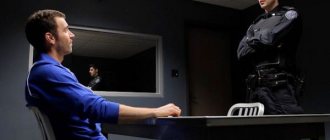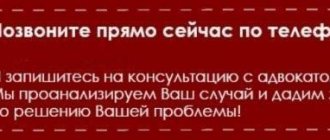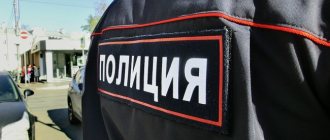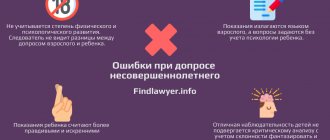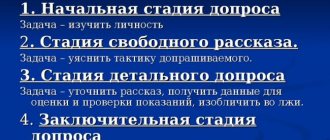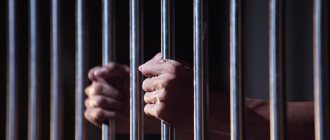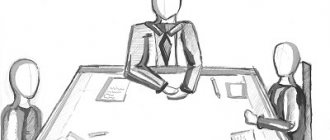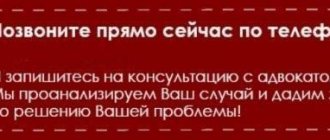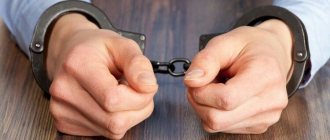PROTOCOL of interrogation of a minor witness
The documents are given according to the Code of Criminal Procedure of the RSFSR
PROTOCOL of the interrogation of a minor witness on September 26, 1989. The interrogation began at 11 o'clock. 40 min. The interrogation ended at 13:00. 05 min. Investigator of the investigative department of the department of internal affairs of the executive committee of the Ensky City Council of People's Deputies of the Enskaya Region, Captain '■%' of the Police Sidorkin I.N. with the participation of teacher Anna Ivanovna Fedotova, ^ Living in Ensk, st. Yu. Gagarina, 7, apt. 18, in the office of the director of secondary school No. 3 in compliance with the requirements of Art. 72-74, 156-160 SHUPK RSFSR interrogated in criminal case No. 37 as a witness a minor: - Viktor Vladimirovich Rakitin - February 12, 1976 - a copy of the birth certificate VO No. 200167, issued by the Civil Registry Office of the city of Ensk - Ensk City of Ensk 1. Last name, first name, patronymic 2. Day, month and year of birth I 3. Document that confirms the age of the witness5. Place of residence 6. With whom he lives 7. Information about parents 8. Place of study or work 9. Was or is a member of a Komsomol organization 10. What kind of relationship was or is he with the accused and the victim - Ensk, Komsomolskaya Square, 4/2, kv, 24 - with parents - father - Rakitin Vladimir Viktorovich, driver of the motor depot, Ensk; mother - teacher of kindergarten No. 18 in Ensk - studies in the 7th grade of secondary school No. 3 - was not and is not a member - I do not know the accused, I live in the same house with the victim, I study in the same class, the relationship between us is normal It was explained to me , which by virtue of Art. 159 of the Criminal Code of the RSFSR, I have the right: to be present during the interrogation of a minor; ask him questions with the permission of the investigator, who has the right to reject the question asked, but is obliged to enter it into the protocol; make written comments on the completeness and correctness of the entries contained in the protocol. I was also explained the obligation, at the end of the interrogation, to confirm with my signature the correctness of the recording of the testimony. Fedotov It was explained to Witness Rakitin that, on the basis of Art. 73-74 of the Code of Criminal Procedure of the RSFSR, he can be questioned about any circumstances to be established in the criminal case under investigation. It is explained that he must give truthful testimony about everything known in this case and answer questions. Rakitin Witness testified: On Saturday, September 13, 1989, I, Nikita Gromov, my classmate, and a friend were returning from school. Since it was a Saturday, we were in no hurry to go home and decided to go through the park. Heroes of Krasnodon. There were few people in the park. We walked slowly, talking about our school affairs. Suddenly, about ten meters in front of us, a citizen appeared. We walked along the alley, and he ran out of the bushes. He shouted something, ran up to us and said: “Guys, give me three rubles, I’ll pay you back tomorrow.” We replied that we did not have that kind of money. Then he grabbed Nikita’s left hand and said: “Take off your watch!” Nikita pulled out his hand and started to run, and this citizen tripped him up. Nikita fell and hit his head on an urn as he fell, crying out “Oh!” He started bleeding. The man cursed and ran into the bushes, and I bent over to Nikita, his eyes closed. I called out to him, but he didn’t answer. Not knowing what to do, I ran to the central exit, to the cinema box office. He ran up to the cash register and said that the worst thing had happened - the boy had been killed. Apparently, I was very scared, the cashier asked me again and, pointing to the second door on the left of a two-story house located not far from the central entrance to the park, said: “Run there, there’s a policeman on duty!” I ran into this room. Opposite the entrance to the premises, in a room whose door was open, a policeman was sitting. I ran into the room and quickly began to explain to the policeman. He jumped up and said: “Let’s run there!” We ran into the alley, ran up to the place where Nikita remained, but there was no one there. I looked around and said: “I don’t understand anything!” The policeman ran forward to the intersection of the alley and the path. Then I hear him shout: “Boy, here!” I ran up, and he showed me a bench about thirty meters away from us and said: “Isn’t that your friend sitting?” I looked and recognized Nidnta. He sat with his handkerchief pressed to his face. We approached him,” after which the policeman said: “How are you, hero?” Nikita said: “You see for yourself!” The policeman asked where the man who attacked you ran? Nikita said that he didn’t know, and I pointed with my hand at the bushes to which this citizen ran. The policeman told us not to go anywhere yet, and he ran, hiding behind the bushes. I took out my handkerchief and gave it to Nikita. I told him to lie down on the bench - on his back. This way the blood will pass faster. Soon the policeman returned, and we came to the duty room. The policeman asked Nikita how he was feeling, took us to the next room and told us not to leave. A few minutes later he called us, put us in the car and told another policeman to take me to the police station and Nikita to the clinic. The police asked me how and what happened. The officer wrote down my story and I signed. Question: Do you remember the man who approached you in the park? Can you recognize him? Answer; I guess I can. Question: Describe it. Answer: He is 15-20 cm taller than me. Hair is black and shaggy. The nose is straight. One upper front tooth is missing. The face is elongated. Question: What was he wearing? Answer: The shirt is light, the jacket is gray, the trousers are dark. I don’t remember what shoes were on my feet. Question: Have you met this citizen before? Answer: No. There are no additions to the testimony. The protocol was read to me, everything was written down correctly from my words. No comments. Rakit in1 Was present during the interrogation. I confirm the correctness of the recordings of the testimony of witness 1*Akitin. The questions asked and the answers to them were recorded correctly, Teacher of Enskoy secondary school No. 3 Fedotova Investigator • drunk police Sidorkin 4. Place of birth 1 The end of the records and subsequent signatures in the interrogation protocol are written in such a way as to exclude the possibility of later additions, corrections between the lines, etc. paragraph 2 The witness signs each page of the protocol. 3 The translator signs each page of the interrogation, 6 Order 5004
Rules for interrogation
The interrogation procedure is determined by Art. 278 Code of Criminal Procedure:
note
In investigative practice, the concepts of questioning and interrogation are distinguished. Thus, only witnesses to a crime, the accused and the victim can be summoned for questioning, and persons not involved in the criminal process can be questioned. Read more on our website here
- The witness testifies separately from other interrogated persons, especially from those persons who have already undergone the procedure.
- Before testifying, the witness:
- provides his personal information, relationship to the accused and the victim;
- is notified of its rights, obligations and penalties referred to in Art. 56 Code of Criminal Procedure;
- gives a subscription confirming familiarization with the specified rules.
- The party that applied for his summons has the right to question the witness first in court. The judge uses this right last.
- If it is necessary to ensure the integrity of a witness, as well as his relatives, personal information is not disclosed. Also, during the procedure, participants in the court hearing are deprived of the opportunity to see the interrogated person.
What are the stages of the procedure?
Interrogation is carried out in the following sequence:
- Preparation.
- Establishing psychological contact.
- Free story from the interviewee.
- Revealing additional information from the interrogated person.
- Providing the witness with the protocol for review.
We will talk about the difference between the concepts of a witness and a witness in this article.
Preparing for interrogation
During interrogation, you need to adhere to pre-thought-out tactics designed to help obtain reliable information. The interrogated person is explained the procedure and the measures provided for refusing to answer questions and providing knowingly false information.
Making contact
A witness may resist the investigator or refuse to testify. It is advisable to conduct communication in a warm, confidential tone and express gratitude for assistance in the investigation. A warning about perjury should be unobtrusive and accompanied by an explanation of its formality.
If there are suspicions about concealment of information or its unreliability, the interviewee must be directly notified of responsibility for possible deviations from the truth. It is necessary to clarify that such violations also include false statements that the eyewitness did not see or does not remember certain circumstances. It is necessary to appeal to the best sides of his personality, to encourage him to fulfill his civic duty.
How should a free story proceed?
The interviewee presents his version of what happened in any order or according to the instructions of the investigator. During the story, it is not recommended to ask questions or comment on what you heard, so as not to confuse the witness.
What questions are asked of the witness?
Remember!
Punishment for perjury is determined by law - from a fine to imprisonment for up to 5 years (for a serious or especially serious crime). Read more about perjury in this article.
The purpose of the questions is to clarify certain points and fill in gaps in the story. Questions may concern additional information that is not directly related to the incident, but will help verify testimony and recall new facts. For this we use:
- Associative connections between forgotten and already told facts.
- Interviewing a witness at the scene. Re-exposure to the scene seen during the crime helps to recall missed moments.
- Repeated interrogation, which may reveal facts not yet known.
Familiarization with the protocol
At the end of the interrogation, the witness is provided with a protocol, the reading of which he confirms with his signature. At the same time, he has the right to make his comments and requests. For example, about the inclusion of drawings or diagrams drawn up by him in the protocol. The interviewee also gets acquainted with the audio recording of the interrogation. After which the protocol is signed by the person who performed the procedure.
Who makes up
Carrying out all procedural activities is within the competence of law enforcement officials. Such persons are investigators tasked with investigating a specific criminal case.
To conduct questioning of witnesses, the investigator has the right to carry out the following actions:
- Carry out procedural measures aimed at identifying and searching for persons who have reliable information about any circumstances related to the crime;
- Call an unlimited number of people for interrogation;
- Repeatedly call witnesses to clarify previously given testimony;
- Draw up protocols based on the results of the interrogation.
Note! The investigator must perform all of these actions in strict accordance with the norms of the Code of Criminal Procedure of the Russian Federation. Violation of procedural norms will entail the exclusion of the interrogation protocol from evidence when considering a criminal case in court.
Article 51 of the Constitution of the Russian Federation and Article 56 of the Code of Criminal Procedure of the Russian Federation
Conducting the interrogation of a witness and drawing up a protocol must provide for compliance with the following mandatory requirements:
- Before starting this process, the witness must be explained the rights and obligations regulated by Art. 51 of the Constitution of the Russian Federation and Art. 56 Code of Criminal Procedure of the Russian Federation;
- The witness has the right to use the services of a defense lawyer, so refusing access to a lawyer will be illegal;
- After preparing the protocol, the witness must not only familiarize himself with the text of the document, but also certify with his personal signature each sheet of the protocol.
After the protocol is drawn up, it is included in the materials of the criminal case and will serve as evidence during the judicial investigation.
Witness interrogation protocol form
Completed sample witness interrogation protocol

